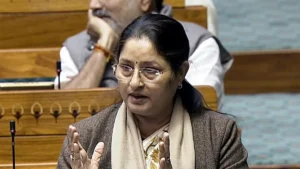President Droupadi Murmu has renamed two important halls in Rashtrapati Bhavan, formerly known as ‘Durbar Hall’ and ‘Ashok Hall’, to ‘Ganatantra Mandap’ and ‘Ashok Mandap’ respectively. This change is part of ongoing efforts to reflect Indian cultural values and ethos within the President’s official residence.
Ganatantra Mandap: A Venue of National Significance
Historical Background
- Former Name: Durbar Hall
- Colonial Legacy: The term ‘Durbar’ originates from Persian, used for courts and assemblies during British rule and earlier Indian kingdoms.
- Historical Use: Hosted important ceremonies, including investiture ceremonies and the swearing-in of Jawaharlal Nehru as the first Prime Minister of independent India.
Rationale for Renaming
- Relevance: The term ‘Durbar’ lost its relevance post-India’s transformation into a republic (‘Ganatantra’).
- Cultural Significance: The concept of ‘Ganatantra’ is deeply rooted in ancient Indian society, making ‘Ganatantra Mandap’ an apt name.
Ashok Mandap: Symbol of Unity and Peace
Historical Background
- Former Name: Ashok Hall
- Original Use: Built as a ballroom for British recreation.
Rationale for Renaming
- Cultural Significance: The term ‘Ashok’ symbolizes being free from suffering and sorrow, and refers to Emperor Ashok, a symbol of unity and peaceful coexistence.
- National Emblem: The lion capital of Ashok from Sarnath is India’s national emblem.
- Cultural References: The Ashok tree holds deep significance in Indian religious traditions, arts, and culture.
Efforts to Reflect Indian Cultural Values
Enhancing Accessibility
Rashtrapati Bhavan, the office and residence of the President of India, is an invaluable national heritage. Continuous efforts are being made to make it more accessible to the public and reflective of Indian cultural values.
Historical Evolution
- Original Construction: Built between 1912–29, designed by Sir Edwin Lutyens as the Viceroy’s House.
- Post-Independence: Became the residence and office of the President of India.
Recent Changes
- Mughal Gardens Renaming: Early last year, Mughal Gardens were renamed “Amrit Udyan” to commemorate 75 years of India’s independence.




 Union Minister Annpurna Devi Inaugurates...
Union Minister Annpurna Devi Inaugurates...
 New Delhi World Book Fair 2026: Free Ent...
New Delhi World Book Fair 2026: Free Ent...
 Amit Shah Inaugurates National IED Data ...
Amit Shah Inaugurates National IED Data ...







